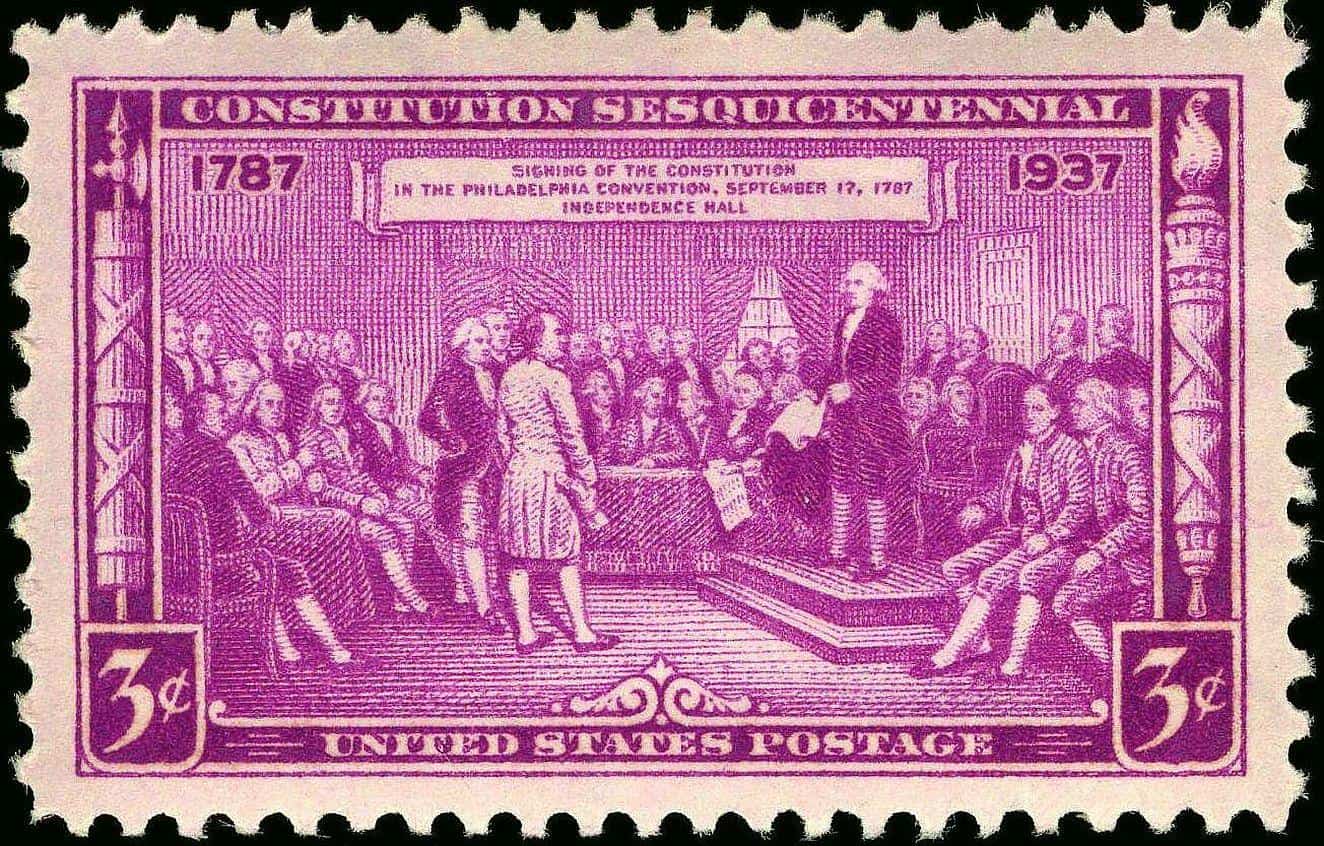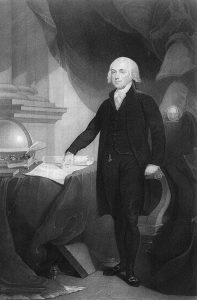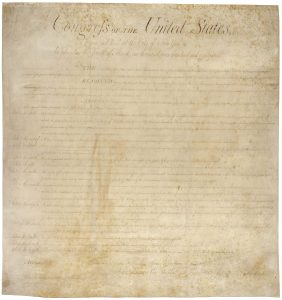The Revolutionary War Was Over, but not the Struggle to Establish a Free and Stable Country
For the first time in human experience, the legislative power of a nation was forbidden from legislating the conscience of man.
—Stephen Mansfield on the first ten words of the First Amendment—“Congress shall make no law respecting an establishment of religion.”1—
Part 1 is available here.
Last week we highlighted We Hold These Truths, a special radio broadcast written by Norman Corwin to commemorate the 150th birthday of the Bill of Rights on December 15, 1941. The program still is important today for many reasons, especially its emphasis on the Founding Fathers’ perspective on rights. The Founders believed that because rights are God-given, government has no authority to take them away. To preserve rights, therefore, government must be prohibited from interfering with individual liberties. The Bill of Rights was created to restrain the federal government of the United States in this way. The historical record of the genesis of the Constitution and the Bill of Rights showcases the Founders’ wisdom in this regard.
After the American Revolution, the thirteen states rejoiced over their independence, but they still were thirteen individual states, each of which, in many ways, acted as an individual country. Previously the war against Great Britain had united these Virginians, New Yorkers, Pennsylvanians, Marylanders, and the residents of the other states, but now other matters confronted the new nation. How could the states work together? Could they establish a central government that would acknowledge states’ sovereignty, yet unify the states to address the issues that would confront them all?2
An attempt was made in the Articles of Confederation. This document was drafted under the authority of the Second Continental Congress, which appointed a committee to begin the work on July 12, 1776. In the latter part of 1777, a document was sent to the states for ratification. All the states had approved it in the early part of 1781. The states now had a new central government, but it wasn’t long before problems arose. The national government was too weak. It had no executive authority and no judiciary. Too high a hurdle had been established for the passage of laws. Furthermore, the states had their own monetary systems, so understandably, buying and selling across state lines became difficult. Without free trade between the states, the national economy was severely hindered. In western Massachusetts in 1786, an uprising occurred when some farmers found that money they had been paid when they were Revolutionary War soldiers wasn’t valid tender for their taxes. The central government was powerless to bring order, although stability eventually was restored anyway. The uprising, which became known as Shays’ Rebellion, was a wake-up call for the entire country. The Articles had to be fixed.3
The Constitution
Accordingly, the states were asked to send their representatives to Philadelphia in May of 1787. This meeting become the Constitutional Convention. Delegates soon realized they shouldn’t try to fix the Articles of Confederation but needed to replace it altogether. The Convention met from May 25 to September 17, 1787. George Washington served as its president. Fifty-five delegates in all worked together to draft a constitution that would effectively address the problems the Articles of Confederation had failed to resolve. As you can tell from the timetable, the task was not easy. At one point when impasses seemed insurmountable, Benjamin Franklin stood to implore the assembly to pray regularly for God’s help in the deliberative process. Here is a dramatic presentation, along with music, relating what occurred. Here is a brief speech about the event. The task remained formidable, but consensus was indeed reached and signatures affixed, and the Constitution was sent to the states for ratification.
One of the Constitution’s brilliant provisions was the division of the government into three separate branches so as to prevent leaders from seizing absolute power. Moreover, this model has its roots in Scripture.
Another issue related to states’ representation in lawmaking. Some delegates said all the states should have an equal say in the making of laws, while others contended that the larger ones should have a greater voice. Delegates reached a compromise in their design of the legislative branch. The lawmaking arm of the federal government—Congress—was divided into two separate bodies, the Senate and the House of Representatives. Every state would have two senators as well as a population-based delegation of representatives in the House of Representatives. No proposal could become law unless it passed both houses of Congress. Thus, states’ interests and the concerns of the people at large would be adequately represented.4
In any contemporary discussion of the Constitution and the liberties it seeks to protect, the question of slavery will understandably arise. If the Founders believed that “all men are created equal,” how could they have allowed the practice of slavery to continue under the new government? This discussion is beyond the scope of this article, but I would commend these resources to you for further study. Also remember that we need to evaluate our Founders not in light of our own culture, but in light of theirs; America’s “Founders were born into a society that permitted slavery.”5 Despite this, some swam against the tide as they expressed resistance and even opposition to the practice. Yet in the end they realized that forcing the issue at this point likely would have have resulted in an unratified Constitution and a divided nation.6
The truth still remains that in and through the Constitution, the Founders set the stage for slavery eventually to be abolished in the United States. Unfortunately, this wouldn’t happen until after a bloody civil war had ended nearly a hundred years later. Nevertheless, it did happen, and the principles upon which America was founded paved the way for slavery’s demise.
On the last day of the convention as delegates were affixing their signatures to the newly drafted Constitution, Benjamin Franklin reflected aloud regarding the image of the sun carved and painted on the back of George Washington’s chair. Was it a rising or a setting sun? Franklin said, “I have often looked at that behind the president without being able to tell whether it was rising or setting. But now I…know that it is a rising…sun.”
With consensus reached among delegates, the support of the people now was needed. Actually, it was essential. As it then stood, the Constitution wasn’t law, but only a proposal. Ratification required formal approval from nine of the thirteen states. Those who believed in a strong national government—a group called the Federalists—supported the Constitution strongly. Anti-federalists, however, were great in number, and typically they opposed the Constitution because it did not have a bill of rights.
Take just over 15 minutes to watch this video about the drafting and ratification of the US Constitution—and how the Bill of Rights became a part of it. Be aware that contributors include individuals with whom we strongly would disagree about certain public policy issues today. For example, Theodore Olson is a strong supporter of same-sex marriage and has worked to advance it, even arguing in favor of it before the Supreme Court in 2013. Susan Herman, president of the American Civil Liberties Union, is a contributor as well. Even so, this particular video is enlightening and informative from a historical perspective.
The Bill of Rights
Larry Schweikart and Michael Allen summarize the first ten amendments to the Constitution in their landmark work, A Patriot’s History of the United States:
The First Amendment combined several rights—speech, press, petition, assembly, and religion—into one fundamental law guaranteeing freedom of expression. While obliquely related to religious speech, the clear intent was to protect political speech.…However, the Founders hardly ignored religion, nor did they embrace separation of church and state, a buzz phrase that never appears in the Constitution or the Bill of Rights. [James] Madison [who is considered the Father of the Constitution and of the Bill of Rights] had long been a champion of religious liberty.…[He] rejected the notion that the exercise of faith originated with government, while at the same time indicating that he expected a continual and ongoing practice of religious worship.…Modern interpretations of the Constitution that prohibit displays of crosses in the name of religious freedom would rightly have been shouted down by the Founders, who intended no such separation.
The Second Amendment addressed Whig fears of a professional standing army by guaranteeing the right of citizens to arm themselves and join militias. Over the years, the militia preface has become thoroughly (and often, deliberately) misinterpreted to imply that the framers intended citizens to be armed only in the context of an army under the authority of the state. In fact, militias were the exact opposite of a state-controlled army: the state militias taken together were expected to serve as a counterweight to the federal army, and the further implication was that citizens were to be as well armed as the government itself! The Third Amendment buttressed the right of civilians against the government military by forbidding the [government forced] quartering (housing) of professional troops in private homes.
Amendments Four through Eight promised due process via reasonable bail, speedy trials (by a jury of peers if requested), and habeas corpus petitions. They forbade self-incrimination and arbitrary search and seizure, and proclaimed, once again, the fundamental nature of property rights. The Ninth Amendment, which has lain dormant for two hundred years, states that there might be other rights not listed in the amendments that are, nevertheless, guaranteed by the Constitution. But the most controversial amendment, the Tenth, echoes the second article of the Articles of Confederation in declaring that the states and people retain all rights and powers not granted to the national government by the Constitution. It, too, has been relatively ignored.7
Then Schweikart and Allen make this critically important observation, a principle that America needs to rediscover today.
These ten clear statements were intended by the framers as absolute limitations on the power of government, not on the rights of individuals. In retrospect, they more accurately should be known as the Bill of Limitations on government to avoid the perception that the rights were granted by government in the first place.8
The above video highlights the distrust of government on the part of the people—especially those who actively fought in the Revolutionary War. The citizens demanded a bill of rights. Although it already had been ratified, the Constitution was accepted when the Bill of Rights, which placed limits on the federal government, was proposed. We thus see that there was, in the minds of this first generation of US citizens (not just the Founders), a direct relationship between the thriving of personal liberties (rights) and restrictions that kept the federal government from intervening in people’s lives.
This truth is echoed in many places. Here is a sampling.
- On its page on the Bill of Rights, the Bill of Rights Institute acknowledges, “One of the many points of contention between Federalists and Anti-Federalists [when the Constitution was debated] was the Constitution’s lack of a bill of rights that would place specific limits on government power.…The Bill of Rights is a list of limits on government power.”
- The American Center for Law and Justice affirms, “The Bill of Rights illustrates that our Founders understood that for personal freedoms to be broad, the power of the federal government must be limited.”
- Lamenting the departure of the Founders’ understanding of rights, David Barton of Wallbuilders writes, “Sadly, in recent years some federal courts have…declared that ‘The purpose of the Bill of Rights is to protect the minority from the majority,’ yet this is ridiculous. No individual is to lose his or her right to free speech, self-defense, the rights of religious conscience, or any other right simply because he or she happens to be in the majority rather than a minority. To the contrary, the Declaration, Constitution, and Bill of Rights were all based on the philosophy that government is to protect the God-given rights of every individual, whether they are in the majority or the minority, from the encroachments of government.”
- Of special significance are these words from the Preamble to the Bill of Rights itself. “THE Conventions of a number of the States, having at the time of their adopting the Constitution, expressed a desire, in order to prevent misconstruction or abuse of its powers, that further declaratory and restrictive clauses should be added: And as extending the ground of public confidence in the Government, will best ensure the beneficent ends of its institution” (emphasis added).
Again, rights and liberties are preserved when government is restricted from forcing individuals to act in certain specific ways. This does not negate the validity of general laws that require or prohibit specific actions for societal cohesion and stability. Constitutional rights can coexist with these statutes. What they cannot coexist with are laws that, in the name of extending rights to all, violate the Constitutional rights of others.
Here’s just one all-too-common example affecting a great many people: Laws and policies that force people like the florist, the baker, the photographer, the artist, and the venue operator to lend their property, time, talent, and other resources to the celebration of a same-sex union against their consciences clearly are not about expanding rights to all people.
- First, no one desiring these services for a same-sex ceremony would have any difficulty finding them, so their “right” to any or all of these services isn’t being denied. These laws, therefore, don’t protect the vulnerable. How are advocates of same-sex marriage vulnerable if they easily can secure the services they want?
- Second, generally speaking, bakers and others aren’t refusing to sell their goods or services to homosexuals; they simply don’t want to be forced to participate in a ceremony that violates their deeply held views on marriage.
- Third, rather than leveling the playing field, laws that force participation in same-sex ceremonies give the proponents of same-sex marriage a legal wedge to coerce those with whom they disagree to celebrate with them. Christian merchants, therefore, can easily be targeted and punished for their beliefs. Whatever happened to the provision that “Congress shall make no law respecting the establishment of religion, or prohibiting the free exercise thereof”?
- Fourthly and finally, such laws represent the antithesis of the philosophy of rights reflected in the first ten amendments of the Constitution—the Bill of Rights. They empower government rather than limit it, and they embolden government to force compliance on one side of an issue still being widely debated on the national stage.
So you see, we’ve traveled a great distance from the Founders’ view of individual rights and liberties in this country. We’ve even come to embrace a philosophy opposed to theirs. Next week, we will explore how we got here; we’ll consider the subtle way in which Americans have been enticed to depart from the Founders’ perspective on rights and liberty. Once we realize how we departed from where we started, we will be better able to return to the place where we began.
Part 3 is available here.
Copyright © 2016 by B. Nathaniel Sullivan. All Rights Reserved.
Notes:
1Stephen Mansfield, Then Tortured Words: How the Founding Fathers Tried to Protect Religion in America and What’s Happened Since, (Nashville: Thomas Nelson, 2007), xvi.
2Marilyn Prolman, The Story of the Constitution, (Chicago: Childrens Press, 1969), 6-8.
3Prolman, 13-15.
4Prolman, 19-20.
5William J. Bennett, America, the Last Best Hope—Volume 1: From the Age of Discovery to a World at War, (Nashville: Thomas Nelson, 2006), 122.
6Bennett, 122-123.
7Larry Schweikart and Michael Allen, A Patriot’s History of the United States: From Columbus’s Great Discovery to the War on Terror, (New York: Sentinel, 2004), 125-126.
8Schweikart and Allen, 126.



Be First to Comment